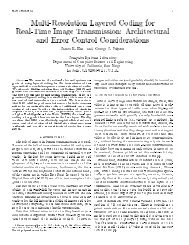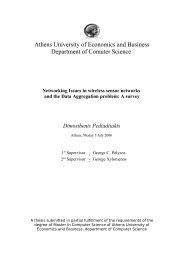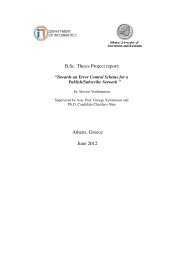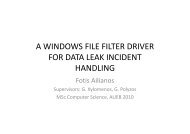The mobile phone as a platform for assisting the independent living ...
The mobile phone as a platform for assisting the independent living ...
The mobile phone as a platform for assisting the independent living ...
You also want an ePaper? Increase the reach of your titles
YUMPU automatically turns print PDFs into web optimized ePapers that Google loves.
4.2.1 Cell-b<strong>as</strong>ed methodsCell-b<strong>as</strong>ed methods [29] determine <strong>the</strong> location of <strong>the</strong> traveller b<strong>as</strong>ed on only <strong>the</strong>visibility of beacons, without using any distance, angle or signal parametersme<strong>as</strong>urements. Localization is b<strong>as</strong>ed on <strong>the</strong> knowledge of <strong>the</strong> limited range of each of<strong>the</strong> beacons, allowing <strong>the</strong> traveller to be localized to <strong>the</strong> region of intersection of <strong>the</strong>ranges of all visible beacons. Given <strong>the</strong> problems with many of <strong>the</strong> o<strong>the</strong>r methods, cellb<strong>as</strong>edmethods are quite popular <strong>for</strong> Bluetooth, <strong>as</strong> well <strong>as</strong> <strong>for</strong> RFID and infrared (IR)technologies.An example of how <strong>the</strong> cell-b<strong>as</strong>ed localization approach works is shown in Fig.4.Consider five beacons, A, B, C, D, and E, with ranges of varying shapes and sizes. Nowsuppose <strong>the</strong> traveller is at some location from which beacons B, C, and D are visible,while beacons A and E are not visible. We may conclude that <strong>the</strong> traveller is located in<strong>the</strong> shaded region. Note that we use in<strong>for</strong>mation on both visibility and non-visibility ofbeacons to determine <strong>the</strong> region of <strong>the</strong> traveller. So, if we <strong>as</strong>sume that <strong>the</strong> location andrange of each beacon in an indoor environment is known, <strong>the</strong>n it is simple to determine<strong>the</strong> location of a travelling <strong>mobile</strong> device b<strong>as</strong>ed on <strong>the</strong> visibilities of beacons using <strong>the</strong>method illustrated by <strong>the</strong> example above.Fig. 4: Cell b<strong>as</strong>ed localization 4An important consideration in cell-b<strong>as</strong>ed methods is <strong>the</strong> shape and size of each cell, i.e.,<strong>the</strong> range of each beacon. In outdoor applications, it is often re<strong>as</strong>onable to <strong>as</strong>sume cellsof a regular shape, such <strong>as</strong> an ellipsoid. However, in indoor applications, such an<strong>as</strong>sumption is not realistic due to channelling and o<strong>the</strong>r artifacts of buildings and <strong>the</strong>ircontents. For example, it is common <strong>for</strong> signals to travel along hallways <strong>for</strong> largedistances, but to attenuate rapidly in a transverse direction due to intervening walls and4 Image courtesy of Sudarshan S. Chawa<strong>the</strong>, Beacon placement <strong>for</strong> indoor localization using Bluetooth[29]24








